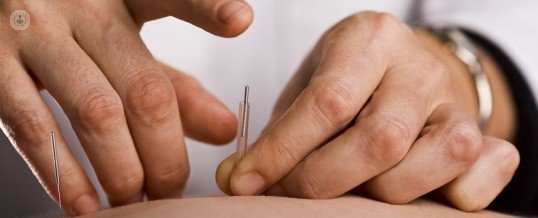dry needling to treat injuries caused by trigger points
Written by:Dry needling acupuncture uses needles to treat painful lesions caused by trigger points. However, it is a totally different acupuncture technique because it acts directly on the lesion. The expert in physiotherapy decide whether the technique is applicable shallow or deep, and the number of sessions required.

Dry needling: what and where acts
Dry needling is a technique that uses acupuncture needles to treat myofascial pain syndrome, caused by trigger points. These points are hypersensitive nodes that are within a taut band in skeletal muscle or its fascia associated. Trigger points can be active (when they cause spontaneous pain without being stimulated with pressure) or latent (when they should be pressed to display pain).
Dry needling as a semi-invasive technique is considered as the needles penetrate the skin, pressing and contracting the trigger point in order to deactivate and reducing pain produced in the patient.However, it notes that is a technique that has nothing to do with acupuncture.
Treatable lesions with dry needling
Dry needling is a suitable technique for muscle problems, back pain or neck pain , tendon problems ... In general, you can treat many musculoskeletal problems that are made with discomfort or limitations on the muscle, and where exploration show trigger points involved.
It is a widely used technique among therapists with very satisfactory results.
Applying the technique of dry needling and sessions required
There are two ways to perform the technique: superficial and deep. In the first the needle is in the subcutaneous tissue overlying the trigger point at a maximum depth of 1 cm, without actually penetrating the muscle. Instead, in the deep yes it works directly on the trigger point.
In deep puncture is usually set a pattern of a weekly session for up to 6 months. If no improvement results do not arise after the third session, the expert in physiotherapy treatment interrupted.
Differences between acupuncture and dry needling
The technique of dry needling is governed by a series of scientific foundations. In contrast, acupuncture there is much controversy regarding its scientific evidence (although in clinical practice has been shown to be effective).
While acupuncture needles are applied at specific points located on meridians, which do not have to be near the injured area in the dry needling the needle is applied directly to the trigger point.
Moreover, dry needling is used exclusively or almost exclusively to treat myofascial trigger points. Instead, acupuncture has applications in many fields, such as pain disorders, digestive, gynecological, urinary and reproductive, weight loss or stress, among others.
Also, the application, the pace of sessions, indications and contradictions between the two techniques are completely different.
Edited by Patricia Crespo Pujante


